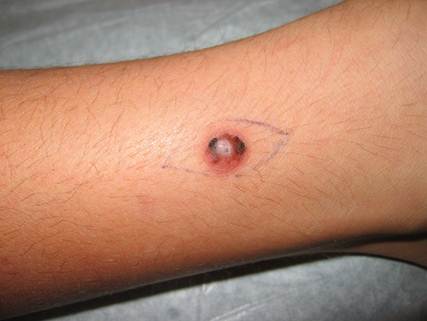
Melanoma is our most dreaded skin cancer. When discovered early, 5 year survival rates are over 95%, just like other skin cancers. Any delay, however, and 5-year survival drops to 40-50%. Early detection is critical, period, because this type of skin cancer can spread through the blood stream to vital organs very quickly.
Melanoma begins when a melanocyte (pigment producing skin cell) goes rogue and starts dividing rapidly. This division is unchecked and results in destruction of adjacent normal tissue. These cancerous melanocytes can come from areas of normal skin, but more commonly arise from dysplastic nevi (also discussed in this section). Paradoxically, melanomas are not painful which makes them far more insidious and hard to catch.
We over-emphasize yearly screens (twice yearly if you have a family history of melanoma), because there is no reason while these deadly cancers can’t be identified early.
Risk factors for developing melanoma include:
Strong family history – A personal history or strong family history of melanoma is the single most important independent risk factor for developing melanoma.
Numerous Moles – More moles, means more melanocytes and a higher risk that any one of these can start proliferating uncontrollably.
Fair Skin – Although Bob Marley died of melanoma, all skin cancers are more commonly found in lighter skin types. Skin cancer prefers redheads too!
Dysplastic Nevi – As mentioned early, these moles are the most mischievous and more likely to turn malignant.
Compromised Immune System, Current or Past – Patients who have received immune-suppressive agents in the past (like chemotherapy or radiation) are at an increased risk of developing melanoma.
Sunburns – Patients who have had at least one blistering sunburn in the past are at an increased risk for melanoma. Keep in mind that the ultraviolet rays you took on between the ages of 0-18 have already determined IF you’ll get skin cancer, but WHEN you’ll get that skin cancer is dictated by how judicious you are with wearing sun protection today.
Geography – It’s no surprise that Australia leads the world in per capita melanoma rates. Aussies take their sun protection VERY seriously. (Kiwis do too).
After a diagnosis of melanoma, it’s important that we stage it by depth (called Breslow thickness) as this is the primary determining factor for how we’ll treat it.
Melanoma in Situ (MIS) is very early melanoma. It’s where we’d like to catch them all. MIS involves the epidermis only and has a very good prognosis. We excise MIS with a margin of normal skin all around of 0.5cm.
Melanomas that are
<1mm in depth. This is a bit deeper than MIS. These lesions require a wider excision that includes a margin of normal skin all around of 1.0cm. One study that tracked 602 patients with melanomas 0.75mm or less found a 4% risk of recurrence and the 5-year survival rate for this group, per the Mayo Clinic, is well over 90%.
Melanomas that are >
1mm in depth. These are more complex malignancies that require a multi-disciplinary approach to treatment. We work closely with surgical oncologists at Mount Sinai Hospital who will craft a mixed surgical and medical plan for these advanced lesions. Treatment begins with a Sentinel Lymph Node Biopsy in an attempt to detect which direction the malignancy is spreading.
With our trademarked cancer screenings, SpotCheck ™, we will get you in and out in no time! Make an appointment on ZocDoc today!